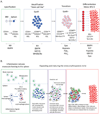Stress erythropoiesis: definitions and models for its study
- PMID: 32750404
- PMCID: PMC7508762
- DOI: 10.1016/j.exphem.2020.07.011
Stress erythropoiesis: definitions and models for its study
Abstract
Steady-state erythropoiesis generates new erythrocytes at a constant rate, and it has enormous productive capacity. This production is balanced by the removal of senescent erythrocytes by macrophages in the spleen and liver. Erythroid homeostasis is highly regulated to maintain sufficient erythrocytes for efficient oxygen delivery to the tissues, while avoiding viscosity problems associated with overproduction. However, there are times when this constant production of erythrocytes is inhibited or is inadequate; at these times, erythroid output is increased to compensate for the loss of production. In some cases, increased steady-state erythropoiesis can offset the loss of erythrocytes but, in response to inflammation caused by infection or tissue damage, steady-state erythropoiesis is inhibited. To maintain homeostasis under these conditions, an alternative stress erythropoiesis pathway is activated. Emerging data suggest that the bone morphogenetic protein 4 (BMP4)-dependent stress erythropoiesis pathway is integrated into the inflammatory response and generates a bolus of new erythrocytes that maintain homeostasis until steady-state erythropoiesis can resume. In this perspective, we define the mechanisms that generate new erythrocytes when steady-state erythropoiesis is impaired and discuss experimental models to study human stress erythropoiesis.
Copyright © 2020 ISEH -- Society for Hematology and Stem Cells. Published by Elsevier Inc. All rights reserved.
Figures


References
Publication types
MeSH terms
Substances
Grants and funding
LinkOut - more resources
Full Text Sources
Other Literature Sources

